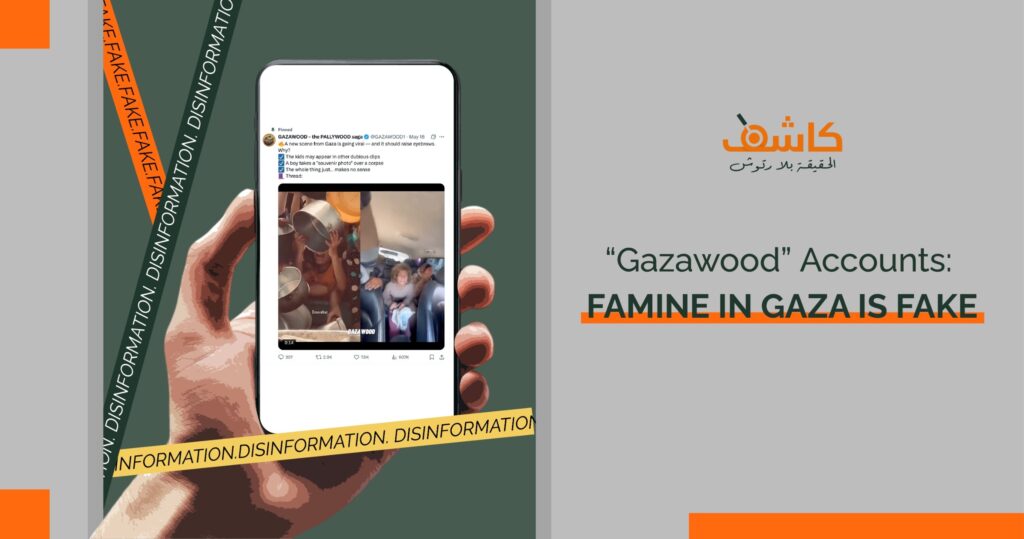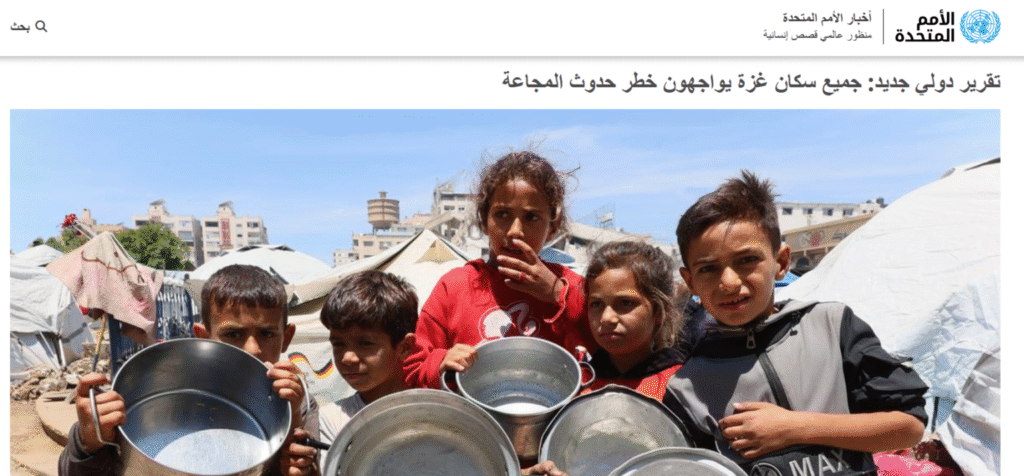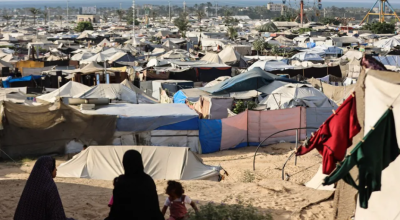Gazawood accounts: famine in Gaza is fake

Accounts operating under the name “Gazawood” on social media platforms—particularly on X—have begun adopting a new form of disinformation aimed at denying the existence of famine in the Gaza Strip. This comes more than 80 days after the Israeli occupation closed the crossings into Gaza and blocked the entry of humanitarian aid and relief supplies.
These accounts, which were created in November 2023, seek to accuse Palestinians and their supporters of fabricating scenes that depict the daily suffering caused by the ongoing assault on Gaza and the West Bank. These scenes include footage of the bodies of martyrs, the wounded, Israeli airstrikes, evidence of torture suffered by released prisoners, and attacks on Palestinian journalists.
The “Gazawood” accounts cast doubt on reports of children dying from cold, claiming that Palestinians use dolls to stage such scenes in order to gain international sympathy. Recently, these accounts have gone further by posting videos of food-related projects in Gaza in an attempt to deny the reality of a genuine famine in the territory.

Exaggeration of Scenes and Distortion of Reality
Recently, “Gazawood” accounts have been reposting videos from Gaza that feature food, beverages, and supplies—videos that were originally shared by their creators. For example, they reshared a video from the “Pizza Pizza” restaurant, another from the “Sweet” café, and a video from the “Shaker Harb” shopping mall. But how exactly do the “Gazawood” accounts use these clips to mislead the public?


- Selective Framing:
“Gazawood” accounts deliberately select videos that highlight food, drinks, and consumer goods, showing people purchasing them. At the same time, they ignore—or actively deny—the existence of footage documenting the extent of the famine in Gaza. They omit videos showing overcrowded community kitchens (known as takiyat) or clips that reveal the physical toll of hunger, especially on children.
- Amplification:
These accounts repeatedly share the selected clips across multiple sources, magnifying their presence online. This repetition creates the impression that such scenes reflect the everyday reality in Gaza, while portraying widespread reports of famine as fabricated or exaggerated.
- Mockery and Dismissal:
Rather than outright denying the famine, “Gazawood” accounts use sarcastic or dismissive language to undermine the narrative. For example, the video from “Pizza Pizza” was captioned: “The media’s favorite diet: hunger stories only”—suggesting that media outlets are spreading false narratives. The video from “Sweet” café was accompanied by the text: “Oh come on. A bit of dessert won’t ruin the whole narrative,” implying that Palestinians are collectively pushing a misleading story about famine.
- Claiming Credibility:
To boost their perceived credibility, “Gazawood” includes the original Palestinian sources of the videos at the end of each clip, often displaying a screenshot of the account that first posted it. This tactic is meant to lend authenticity to their misleading claims.
Context Stripping
The tactics employed by “Gazawood” accounts amount to nothing more than selective framing that strips content from its broader context, ultimately misrepresenting the reality on the ground. The existence of a few businesses related to food, beverages, and supplies does not disprove the presence of famine. These isolated examples cannot be used to counter the findings of international organizations, local institutions, and journalistic reports that clearly confirm the existence of a famine in the Gaza Strip.
What Do Journalists Say?
Journalist Salma Al-Qaddoumi told Kashif that the famine in Gaza has spread “horribly,” especially after more than 80 days of complete closure of the border crossings and the prevention of any aid or goods from entering the Strip. She explained that markets are nearly empty of essential food items such as flour, rice, and canned goods, and that most community kitchens (takiyat) have shut down due to a lack of supplies.
Al-Qaddoumi emphasized that the videos circulated by “Gazawood” accounts do not reflect the actual situation in Gaza, but instead depict individual projects that are themselves under constant threat of closure. Many of these businesses had stored supplies during earlier brief openings of the crossings, but most have since shut down as their stocks ran out.
Photojournalist Abdel Hakim Abu Riyash told Kashif that securing food on a daily basis in Gaza is “extremely difficult” due to severe shortages of basic goods and the disappearance of flour from the markets. Even when food is available, prices are prohibitively high. Families are often forced to survive on one simple meal per day, which may cost around 100 shekels for a small family. For example, a kilo of tomatoes or eggplant can cost 30 shekels, while a kilo of potatoes has reached 50 shekels.
Abu Riyash attributes this dramatic price surge—which places a huge burden on families and limits their ability to purchase necessities—to the closure of the crossings and the Israeli military’s control over vast areas of farmland, making them inaccessible to locals. He also noted that while many families had turned to community kitchens for food, the portions were minimal, and some families received no meals at all. Most of these kitchens have now shut down due to a complete depletion of cooking supplies.
Journalist and human rights advocate Nesma Al-Halabi noted that Gaza’s markets are nearly void of staples such as flour, rice, lentils, canned goods, and vegetables following the closure of crossings. Prices have doubled—even for low-quality goods. For instance, 250 grams of onions can cost as much as 80 shekels, forcing people to buy individual onion slices. Tomatoes and cucumbers are priced between 40 to 50 shekels per kilo.
Al-Halabi also pointed to a severe liquidity crisis. Even those who are still employed must rely on intermediaries to withdraw their money—often at a steep commission of up to 40%—which further reduces their purchasing power amid the skyrocketing prices.
She added that Gaza residents also face extreme difficulty accessing drinking water, which is often contaminated and leads to widespread illness.
Businesses Are Shutting Down
Shadi Abu Sarar, owner of the dessert shop Al-Batikha, told Kashif that launching his project during the ongoing assault on Gaza was almost “impossible” due to the severe lack of resources and raw materials needed to produce sweets. He explained that he managed to purchase basic ingredients during a brief opening of the crossings—but at extremely high prices—and stocked them in advance.
Abu Sarar confirmed that, following the closure of the crossings, he had to stop selling desserts entirely and has since only been offering hot beverages using what limited resources are available. He noted that he now relies on firewood and a kerosene stove due to the lack of gas and constant power outages.

As for Mohammed Al-Amareen, owner of Pizza Pizza and the Pizza Food Truck—from which one of the videos shared by the “Gazawood” accounts was taken to deny the existence of famine—he told Kashif that the video was from the Pizza Pizza restaurant he had opened three months ago, aiming to offer a small moment of relief to Gaza residents amid the devastation. However, he was soon forced to close the restaurant due to escalating danger, fears of Israeli targeting, and the growing shortage of essential pizza ingredients caused by the sealed crossings. When available, these ingredients are extremely expensive: a kilo of sugar can cost up to 100 shekels, flour around 120 shekels, and za’atar 100 shekels.
Al-Amareen added that he had also launched the Pizza Food Truck project— a mobile pizzeria that operated through an online platform and partnered with relief organizations to distribute pizzas for free to children in Gaza. However, he hasn’t launched any such initiative in the past two months due to the continued closure of the crossings, the unavailability of raw materials, the dangerous road conditions, and the lack of diesel fuel required to operate the food truck.

Reports from International Organizations and Local Institutions on the Famine
Bisan Abu Jayab, Director of the Women’s Affairs Technical Committee in Gaza, emphasized that the limited humanitarian aid allowed into the Strip since the beginning of the aggression has been far from sufficient to meet people’s needs. She confirmed that, following the closure of the crossings, basic supplies have been entirely cut off, leading to the spread of famine that has resulted in the deaths of civilians—especially children—as well as widespread cases of anemia.
Speaking to Kashif, Abu Jayab described the current situation in Gaza as a “war of starvation” and said it is the “most horrific phase” the Strip has experienced since the beginning of the aggression. She highlighted the severe scarcity and disappearance of food supplies, and noted that the stocks of the World Food Programme, UNRWA, international organizations, and community kitchens (takiyat)—which provide displaced persons and shelter centers with a single basic meal per day—have been completely depleted, leaving them unable to continue serving the population.
She also pointed to the shortage of baby formula and essential infant supplies. When these are available, they are sold at extremely high prices beyond the reach of most families. Additionally, bakeries and shopping centers have closed due to the lack of flour and the unaffordable cost of firewood, which is being used as an alternative to cooking gas. Stocks of food and supplies have been completely exhausted.
Abu Jayab further stated that the Israeli claims of allowing humanitarian aid into Gaza are false and misleading, noting that only a small number of trucks have been allowed in so far—nowhere near enough to meet the needs of the population.
In the same context, the World Central Kitchen announced on 8 May 2025, that it had halted all humanitarian operations in the Gaza Strip due to the complete depletion of food supplies and cooking fuel required for preparing meals and baking bread. This was a direct result of the Israeli siege and the closure of crossings since early March.
The organization’s founder, Chef José Andrés, said: “Our trucks are ready to move, but they can’t without authorization. The flow of humanitarian aid must be allowed.”
Amjad Al-Shawa, head of the Palestinian NGOs Network in Gaza, warned that most of the community kitchens—on which around 40% of the population depends for a single daily meal—are on the verge of shutting down due to the lack of supplies and the ongoing blockade. He stressed that this could lead to an unprecedented humanitarian disaster, especially as cases of malnutrition continue to rise among children and women.
On 8 May 2025, the network officially announced that a large number of these community kitchens had already ceased operations due to the depletion of their food stocks.

UN and International Reports on the Famine in Gaza
A report issued by the United Nations and other international bodies on 12 May 2025, stated that “the entire Gaza Strip is facing a high risk of famine as fighting escalates again, border crossings remain closed, and food scarcity becomes increasingly dire.” The report emphasized that hunger and malnutrition have significantly worsened since 2 March, when the entry of all humanitarian aid was halted. It also highlighted that the vast majority of Gaza’s children are experiencing severe food deprivation.
The report explained that the closure of Gaza’s crossings for over two months—the longest shutdown ever faced by its residents—has driven food prices to “astronomical levels,” rendering the limited available food inaccessible to most families.

The UN report, widely circulated on 12 May, further quoted Catherine Russell, Executive Director of UNICEF, saying:
“Famine risk doesn’t appear out of nowhere—it unfolds in places where food is blocked, health systems are destroyed, and children are left without the minimum required to survive.”
She added:
“Severe hunger and malnutrition are a daily reality for children across Gaza. We’ve issued repeated warnings, and we again urge all parties to act now to prevent catastrophe.”
Similarly, Abdelhakim Elwaer, FAO Assistant Director-General and Regional Representative for the Near East and North Africa, told CNBC on 19 May 2025, that “the Gaza crisis is the most acute globally” in terms of the number of people facing extreme food insecurity. He reported that more than 93% of Gaza’s population is in the emergency phase, with 244,000 people already in the phase just prior to famine.
On the same day, Tedros Adhanom Ghebreyesus, Director-General of the World Health Organization, addressed the annual World Health Assembly in Geneva, affirming the imminent famine threat in Gaza. He stated that two million people in Gaza are suffering from extreme hunger and attributed the worsening of the crisis to the “deliberate obstruction” of humanitarian aid. He emphasized that “tons of food are sitting at the border just minutes away,” underscoring the man-made nature of the disaster.
Meanwhile, on 21 May 2025, the Government Media Office in Gaza announced the entry of 87 trucks carrying various forms of aid, allocated for distribution through international and local organizations.
Ismail Al-Thawabta, Director of the Government Media Office, told Kashif that the trucks contained flour, food supplies, nutritional supplements for children, and medications. However, he clarified that, as of the report’s publication, these aid shipments had only reached southern Gaza, with no access to the central or northern areas of the Strip.
This amount of aid is vastly insufficient in comparison to the population’s needs. According to UNRWA spokesperson Adnan Abu Hasna, Gaza requires more than 600 aid trucks per day to even begin addressing the scale of the famine. Before the war, the daily average was around 500 trucks.










